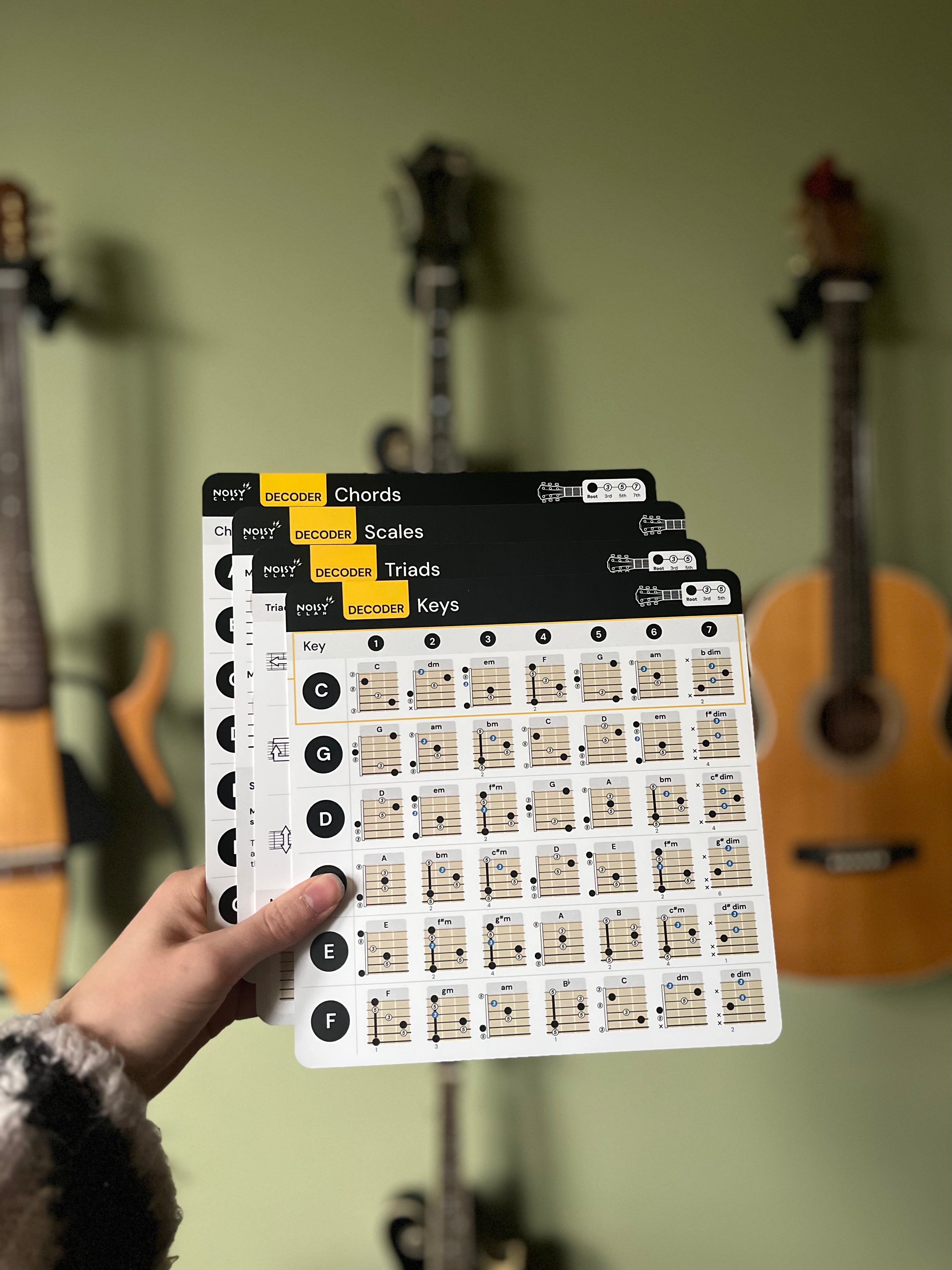Welcome to the start of a new era! A world where making noise has never been easier. Let’s talk about Noisy Clan’s Cheat Sheets for Guitar. I’m going to delve into the significance of keys, chords, scales, and triads in guitar theory, exploring why this knowledge is crucial for any aspiring musician. You can also click here to download a chord formula chart to accompany your cheat sheets.
Before we begin, here is a brief fretboard anatomy:

Scales
You've likely come across the term "scales" in the course of your guitar journey, but some players may not be entirely clear on their significance. Guitar scales consist of organised sequences of notes, played either in an ascending or descending order. Engaging in scale practice not only fosters familiarity with the fretboard's notes but also refines your musical ear and establishes a structural foundation for crafting original melodies.
On our Scales Cheat Sheet, one scale position is pulled out and highlighted on the left hand side of the page. In fact, the highlighted scale position is also reduced to just the first half of the fretboard (one octave) which makes it very approachable if you have never studied scales before.
If you want to dive deeper to practise and connect them, all the scale positions are shown on the right hand side. There are a number of scales shown including the Major, Minor, Natural Minor and Pentatonic.
Extend your exploration to the Minor scale, known for conveying a mood of melancholy and introspection. Both the Major and Minor scales play pivotal roles as foundational elements in numerous musical compositions, rendering them essential for any budding guitarist.
Triads
The Decoder Cheat Sheet for Triads shows the 12 major triads on the guitar. The major triad is the minimum number of notes required to form a complete chord, formed of three note intervals. The root, the major third and the perfect fifth.
The Cheat Sheets show the 1, 3 and 5 for each inversion of the chord. They don’t show the fingering, but rather how each triad is constructed, which is less prescriptive.
The first side shows the three chord inversions for each of the 4 string groups possible, a total of 12 major triads.
For instance, I can look at the third line highlighting the G, D and A strings and see how the three triads are played on just these strings. These three triad shapes are all the same chord, just different inversions of the same note:

Keys
Our Keys Cheat Sheet organises the 12 major keys into a handy circle. A key is a family of notes and chords that work with the tonic or root of the key. Each key has a unique set of seven notes that form the framework for melodies and harmonies.
The circle isn’t arranged A, A#, B, C etc. The Circle of 5ths arranges the keys by closeness starting at the top with the key of C, which is the only key that contains natural notes. The keys are separated by an interval of a fifth (hence the circle of fifths!). This means that for example G is a fifth away from C. In the opposite direction, the interval between keys is a fourth.
The two keys closest to C are F and G. The key of G shares all the same notes except the F#. The key of F shares all the same notes as C except the Bb. These note changes are captured in the grey tabs around the circle which show the key signature differences for each key.
Check out our digital decoder, if you haven't done so already to get to grips with how keys actually work in cohesion with each other. The Decoder cleverly only shows you the relevant information for each key you are focusing on.
Chords
Noisy Clan’s Chord Chart has been designed to visually aid guitarists through each chord, showcase the anatomy of a chord, and how you can learn to play them yourself.
So let’s get started with some quick orientation. The strings on this chord chart are represented horizontally, and the frets vertically. The reason for this is simple, it just feels easier to read!
An “X” next to a string indicates that the string should be muted when strumming a chord. To mute a string, you fret a note on a string but lay your finger down slightly flat. This way, it barely touches and mutes the following strings
Notes shown on the fretboard should be fretted, while notes shown to the left of the nut are open strings which you should let ring out.
You can click here to read more in depth about our chord chart!
So there you have it! This really is the tip of the iceberg, I hate to break it to you. That being said, we all have to start somewhere, and these Cheat Sheets really do just that. Start you somewhere. Designed with one goal in mind – to get you playing more guitar!








